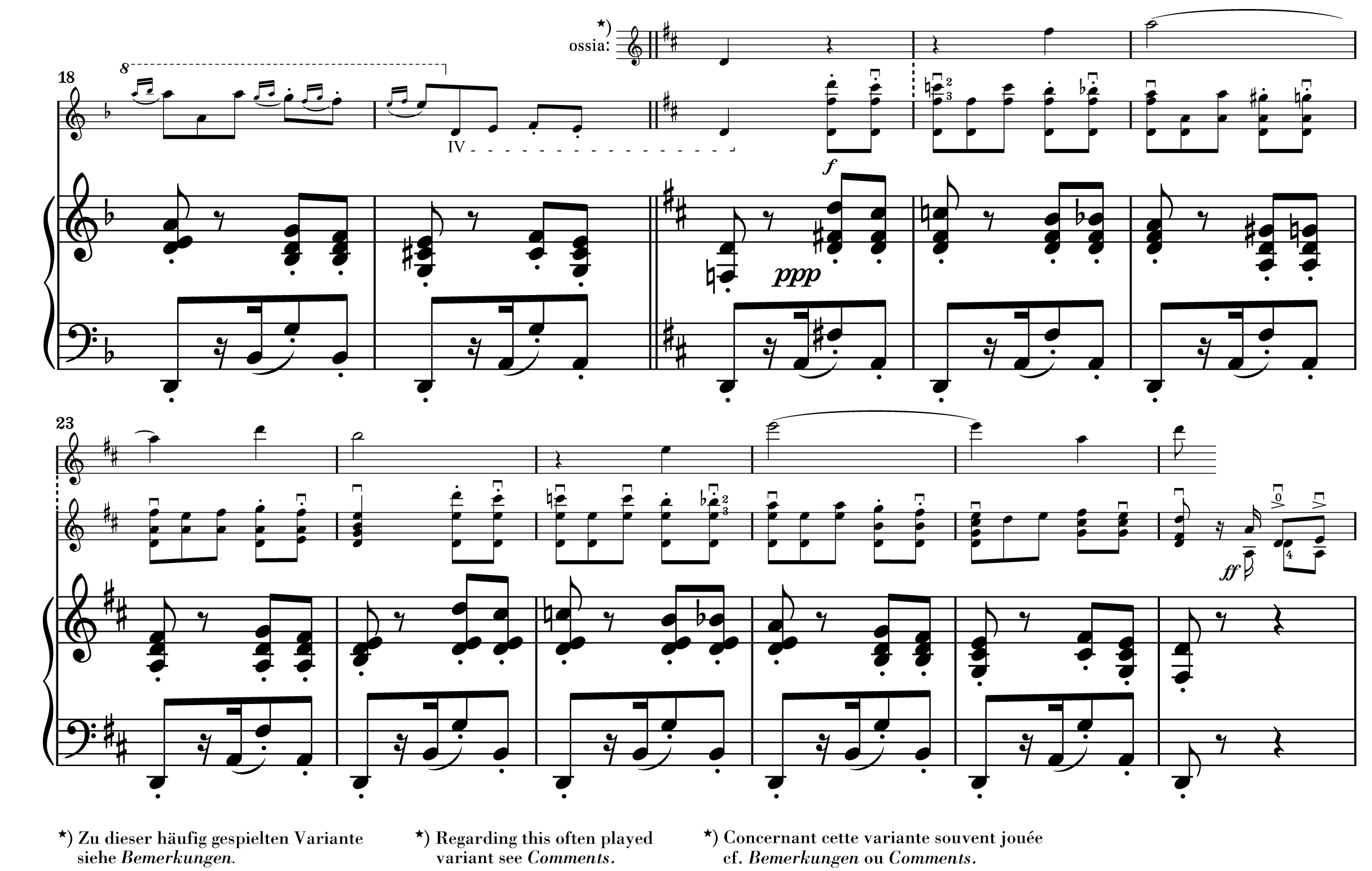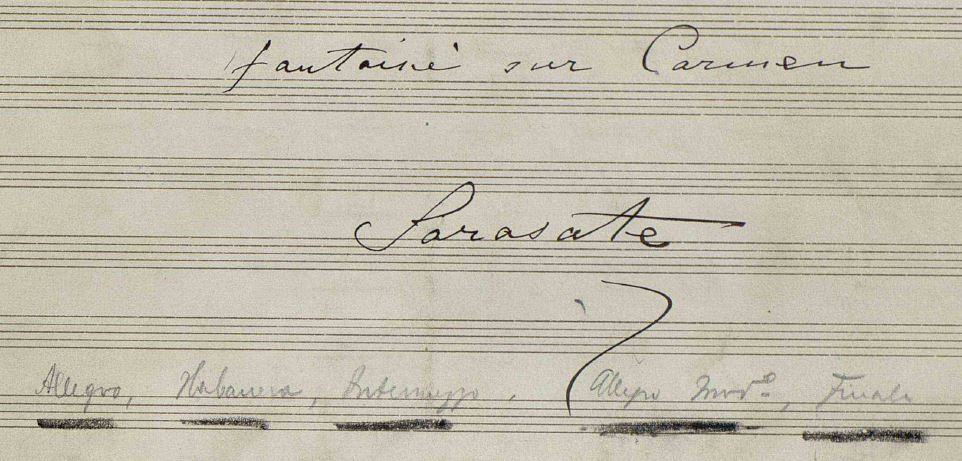To this day, the success of a new stage work crucially depends upon whether the individual scenes, ensembles or songs stick so strongly in the mind as catchy tunes that they become earworms. The persistent popularity of Georges Bizet’s Carmen undoubtedly owes a great deal to such of its easily-remembered numbers. Its première in the Paris Opéra-Comique on 3 March 1875 and the run immediately afterwards did not bring the great hoped-for success, but from the autumn of 1875 an unprecedented triumphal procession over European stages began – which, though, Bizet, who died three months after the première, was no longer alive to experience.
From the outset, Habanera, Carmen’s entrance song “L’amour est un oiseau rebelle” (“Love is a rebellious bird”) was amongst the opera’s most popular numbers. So it is no wonder that Pablo de Sarasate prominently put it as No. 1 after the Introduction in his Carmen Fantasy, composed for violin and piano (or orchestra) in 1881. At any rate, Sarasate chose numbers that were especially responsible for the Spanish colouring of Bizet’s opera – and the absence of Habanera would probably have been all the less likely since its melody goes back to an original Spanish song, to Sebastián de Iradier’s El arreglito. (In the 19th century El arreglito was just about as popular as Iradier’s second great song success, La Paloma, would become in the 20th century.)
In his opera fantasies Sarasate usually worked according to the theme-and-variations model. So, he had the number begin almost literally like the original, adding to it only appoggiaturas and enlivening the quaver triplets by dropping the middle note an octave:

Bizet, Carmen, Carmen’s part from the first edition of the score (1877), no. 5, Habanera, measures 1–6.
After the change from d minor to D major (as of measure 20), Sarasate varied the theme by embedding the chromatically descending melody in double and triple stops.
In preparing the recently-published Urtext edition of the Carmen Fantasy, Augustin Hadelich, who advised on the solo part, brought to my attention the fact that in this passage (measures 20–28) violinists would frequently play a cantabile counter melody to the theme repeated in the piano or orchestra, that is, the melody from Carmen’s repetitions of the crucial word “L’amour” in Bizet’s original, simply lengthening the duration of the tone and placing it an octave higher. Although I had noticed this variant, I had, as it turned out, underestimated how widespread it was.

Bizet, Carmen’s part according to the first edition of the score (1877), no. 5, Habanera, measures 20–28.
This does not show up in either the manuscript or the printed sources for the Carmen Fantasy; it certainly does not come from Sarasate himself. How and when, then, did it enter into Sarasate’s composition? Upon examining other violin fantasies on Bizet’s Carmen, I soon came across Franz Waxman’s Carmen Fantasie for violin and orchestra, composed in 1946, which also deals with Bizet’s Habanera and transits to D major, using the counter melody in question:
Waxman (actually, Wachsmann), originally from Germany, made his name in the US in the 1930s and 1940s as arranger and film composer. The fantasia on Carmen themes composed as part of his music for the film Humoresque is one of his best-known works, popularised especially by Jascha Heifetz who played it over the radio and in concerts. It seemed obvious that Heifetz must also have effectively incorporated this melody within the classic of the Carmen arrangements, in Sarasate’s Carmen Fantasy.
Fellow Henle editor, Ray Iwazumi (Juilliard School), who is very familiar with the American violinist scene, dismissed, though, my surmise with good arguments: “The problem with this hypothesis is that it’s not too difficult for any creative musician who knows the original opera to make this leap of substituting ‘l’amour, l’amour’ in this passage – it comes straight from a very memorable melodic gesture sung by the heroine.”
Be that as it may: The question arose as to how we should deal with it in our Sarasate edition. The substance of the Urtext idea is to free the music text of all extraneous alterations or additions – which would actually exclude this extrinsic variant. The prevalent practice cannot, though, be entirely blocked out, for a violin student using an Urtext edition is likely to be confused at not finding any reference whatsoever to a variant that is known from numerous recordings.
Here, we have a special situation in that a kind of meta-editing has occurred in the replacement of Sarasate’s original music text by an arrangement that is closer, curiously enough, to the original Carmen text than Sarasate’s composition is. Whereas Sarasate ignored Carmen’s melodic counterpoint, since his interest was focused on virtuoso variations of the underlying theme, this passage maintains Bizet’s basic conception, since the right hand in the piano retains the theme (= chorus in the opera), whilst the violin superimposes the cantabile gesture (= Carmen’s song).
We ultimately decided to include the frequently played variant as an ossia, whilst making it clear in the comments that this does not go back to Sarasate:
 It remains to be seen which is the more beautiful arrangement, that with Sarasate’s original music text or that with the Carmen variant. Here, in closing, is the evidence from the relevant recordings:
It remains to be seen which is the more beautiful arrangement, that with Sarasate’s original music text or that with the Carmen variant. Here, in closing, is the evidence from the relevant recordings:
Original with Ingolf Turban (Habanera from 2’52”)
Variant with Augustin Hadelich (Habanera from 2’48”)






Since I fall into the category of “[those] likely to be confused [by a disparity between the printed editions and] numerous recordings” I was really delighted to find your lucid explanation and discussion.
I wonder whether your policy regarding commonly practiced additions to the score extends to commonly practiced excisions.
I ask this question because I notice that in at least two performances available on YT–namely, Izthak Perlman and Chloe Chua (who for all I know is just following Perlman’s lead)–utilisation of the ossia is accompanied by the excision of the violin solo bars 28-43 immediately following.
Suppose that these two instances generalizes, i.e. so that the common practice in question consists of the ossia *and* the excision. Would it be your policy in the Ur-text to signal (and ideally explain for the benefit e.g. of violin students) not only the ossia but also the excision?
(I ask this question as a point of principle applicable to other cases, and so independent of the answer to the question as to whether the case of Perlman and Chua really does generalize. I haven’t checked other performances that utilise the ossia, and so do not know either way.)
Dear Mr. Burgess,
Thank you for your very interesting comment.
We are committed to the Urtext concept in our editions, but we cannot completely ignore the reception of the work in question. In the present case of the “Carmen Fantasy” we discussed for a long time whether or not we should consider the ossia in the musical text. We did it here because the Ossia is closer to the original work than Sarasate’s adaptation as explained in the blog.
But what do you do in the event of cuts? I think we should always indicate cuts (in the Comments or as a footnote) when they have become generally accepted. In the Habanera of the “Carmen Fantasy”, bars 28-43 and often 103-108 (see, for example, Perlman) are shortened, but there are also many violinists who do not make these cuts (including Augustin Hadelich, who made the fingerings for our edition). So we cannot say that the cuts are common practice.
But ultimately this remains a matter of discretion for the editor.
Could the reason it is played more than the original version by Sarasate be because of this recording of Zibalist?
This recording of Efren Zimbalist was from around 1936, 10 years before Waxman composed his arrangement, yet he does the same thing most violinist do now while playing the Habanera.
This is the earliest recording I can find of this piece, if you find one older, please link it!